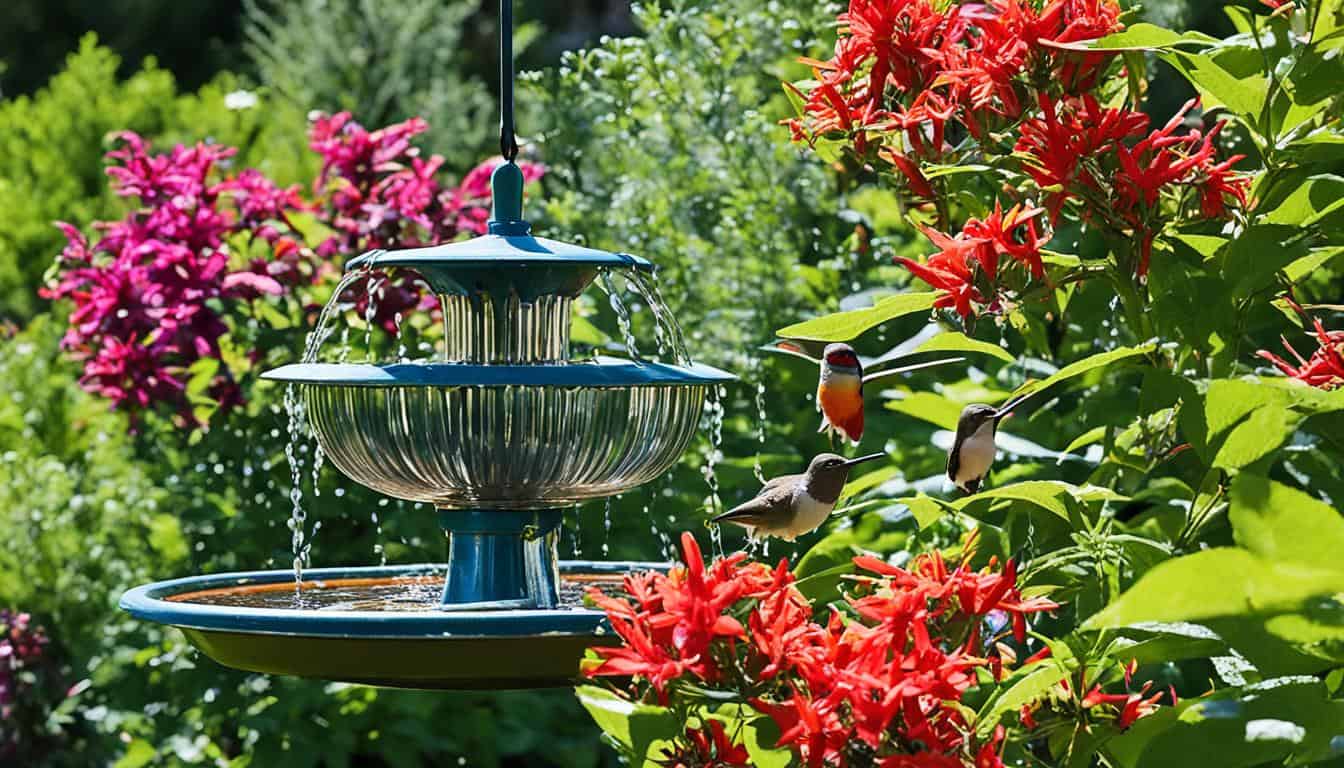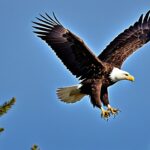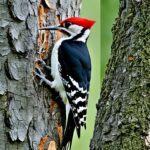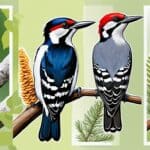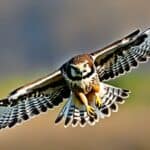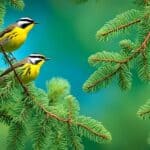Want your yard to be full of life? Add some native plants to attract hummingbirds. They love these, especially the Rufous Hummingbird. This bird travels far and wide for nectar.
It’s all about the nectar for them. Make sure your yard always has delicious flowers and feeders. And remember, they need a place to perch and not a trace of pesticides.
Not only nectar, but water is vital too. These little birds need places to bathe. They also rely on a garden filled with nectar, pollen, and tiny bugs.
Understanding Hummingbird Behavior
Hummingbirds need a lot of food every day because of their fast metabolism. This means they have to eat often. They mostly drink nectar from many kinds of plants to get their energy.
Audubon’s Hummingbirds at Home project studies how these birds eat, especially with climate change. Knowing this helps us make places where hummingbirds can live better.
If you understand how hummingbirds act, you can make a perfect yard for them. This includes planting different flowers for nectar and knowing where they look for food. Making your garden based on this can help the birds and make you enjoy watching them more.
Choosing the Right Native Plants
To attract hummingbirds to your garden, pick native plants. They should be rich in nectar. These plants both feed hummingbirds and help our environment.
Best Native Plants for Hummingbirds
Plants like Beebalm, Coral honeysuckle, Cardinal flower, and Sages work well. They create a colorful ecosystem. Here’s a list of plants that are great for hummingbirds:
| Plant | Scientific Name | Bloom Period | Nectar Value |
|---|---|---|---|
| Beebalm | Monarda fistulosa, Monarda didyma | Mid-summer to early fall | High |
| Coral honeysuckle | Lonicera sempervirens | Spring to fall | High |
| Cardinal flower | Lobelia cardinalis | Summer | High |
| Sages | Salvia coccinea, Salvia spathacea | Spring to fall | High |
Plant these flowers to have food for hummingbirds all year. Your garden will be their favorite spot. They’ll come back often.
Creating a Hummingbird Garden
For a hummingbird garden, plan carefully to draw in these colorful fliers. Make sure your garden has different plants and flowers. This mix will look beautiful and offer food and shelter to hummingbirds.
Layering Plants
In a hummingbird garden, layering plants, shrubs, and trees is key. This method means there’s always something in bloom. It also gives the birds places to nest and rest. The taller plants provide lookout spots, while smaller flowers are rich in nectar. This mimics a hummingbird’s natural environment.
Color Selection
Choosing the right colors is vital in a hummingbird garden. Aim for rich reds and oranges, especially with tubular flowers. These shades catch the birds’ attention. By mixing these colors together, your garden will be a hummingbird magnet. Keep in mind when each flower blooms to ensure nectar all year round.
By having a mix of plants that bloom at different times, you guarantee a steady supply of nectar. With these tips, your garden will be a perfect spot for hummingbirds. Plan well and enjoy the delightful visits all year long.
| Plant Type | Examples | Blooming Period |
|---|---|---|
| Tall Trees & Shrubs | Red Buckeye, Flame Azalea | Spring to Early Summer |
| Perennials | Bee Balm, Hummingbird Mint | Summer to Early Fall |
| Annuals | Scarlet Sage, Zinnias | Summer |
Placement of Hummingbird Feeders
Getting the right spot for your hummingbird feeder is key. Start by choosing a shaded area. This keeps the sugar water in the feeder fresh.
Make sure to put feeders for hummingbirds far from each other. It avoids fights between the birds. This means more birds can enjoy your yard peacefully.
Keeping the feeders clean is also really important. Clean them often to stop mold. Also, change the nectar to make sure it’s healthy and tempting for the hummingbirds.
Here’s a handy guide for where to place your hummingbird feeder:
| Aspect | Recommendation |
|---|---|
| Location | Shaded Area |
| Spacing | Spread Out |
| Cleanliness | Regular Cleaning |
| Nectar Refresh | Consistent Renewal |
How do you attract hummingbirds to your yard in the USA?
To attract hummingbirds to your yard, make it welcoming and supportive. Cultivate a hummingbird-friendly yard with lots of native plants and flowers. These plants meet their food needs with nectar all year round.
Placing feeders strategically is key to inviting hummingbirds over. Put them in the shade to keep the nectar fresh. Clean feeders regularly to ensure a healthy meal. Watch their migration to understand when to have feeders and flowers ready.
Avoiding pesticides fosters a healthier eco-system. This means more small insects, an important part of a hummingbird’s diet, can live. By following these USA hummingbird attracting tips, and noting their habits, you’ll keep your yard buzzing with hummingbirds.
- Plant native, flower-rich gardens
- Place feeders strategically
- Observe migratory patterns
- Maintain a pesticide-free environment
Here’s a simple overview to make your yard hummingbird-friendly:
| Consideration | Tip |
|---|---|
| Plants | Choose native varieties that bloom in different seasons |
| Feeders | Place in shaded areas and clean regularly |
| Ecosystem | Minimize pesticide use and support insect populations |
| Observation | Track migratory patterns to adjust habitat as needed |
Providing Water Sources
Water is key for a hummingbird haven in your yard. These little birds need it for drinking and bathing. Including various water features will make them keep visiting.
Using Misting Devices
Misting devices catch hummingbirds’ eyes with their fine mist. The birds enjoy flying through the mist and bathing in it. It is a great addition to your yard that combines well with natural perches from plants.
Bird Baths
Traditional bird baths with shallow basins are great for hummingbirds. They can drink and bathe in them easily. Add a fountain or dripper for extra allure. Also, remember to keep the baths clean and water fresh.
Think about these points when picking water sources for hummingbirds:
| Water Source | Advantages | Considerations |
|---|---|---|
| Misting Devices | Creates mist, attracts attention, easy to install | Ensure regular maintenance, can be costly |
| Bird Baths | Provides drinking and bathing water, versatile | Shallow depths needed, regular cleaning required |
Ensuring Safe Perches
Making sure your yard has safe perches for hummingbirds is key. It makes a welcoming place for these small birds. They need spots to rest and watch over their area, both natural and made by people.
Natural and Artificial Perches
Places like branches and shrubs are very important. These are native plants with strong branches. They make perfect spots for hummingbirds to rest near their favorite flowers.
If there aren’t many natural perching spots, you can add artificial perches. These could be pretty hooks or special rods. They let hummingbirds rest near feeders safely. A mix of both natural perching spots and artificial perches makes your garden a great home for these birds.
Minimizing Pesticide Use
Keeping a pesticide-free garden is key for hummingbird safety. It also makes your garden better for wildlife. Pesticides harm the insects that hummingbirds need for food. They also hurt the health of the birds.
To start a pesticide-free garden, use natural methods for pest control. Here are some ways to do it:
- Bring in helpful bugs like ladybugs and praying mantises. They eat the pests that harm your plants.
- Grow plants that bugs don’t like. Marigolds and basil are good examples.
- Make or buy natural bug sprays. Things like neem oil are good and safe for animals.
- Check your plants often for bugs. Remove them by hand if you see any. This stops bug problems without using chemicals.
These natural ways not only help the hummingbirds but also make your garden full of different wildlife. This creates a diverse and healthy area for all creatures.
Think about how natural and normal pest control compare:
| Aspect | Traditional Pest Control | Natural Pest Control |
|---|---|---|
| Cost | Often higher because of chemicals | Cheaper with homemade options |
| Environmental Impact | Can be bad for local nature | Less harm, helps your garden be healthier |
| Effectiveness | Works fast but bugs can get used to it | Works well over time, bugs don’t get used to it |
| Hummingbird Safety | Dangerous for hummingbirds | Doesn’t harm hummingbirds |
Choosing natural pest control makes your yard safer for all animals. It also helps your garden be a refuge for hummingbirds and other wildlife.
Planting for Seasonal Blooms
To attract hummingbirds all year, focusing on seasonal blooms is key. Create a garden with a mix of continuous blooming plants for these birds. The right plants provide a steady nectar supply and make your outdoor space more appealing.

Continuous Blooming Plants
When planning a garden for hummingbirds, pick plants that bloom at different times. This ensures a steady nectar supply, keeping these birds around. Consider the following plants:
- Spring: Columbines (Aquilegia spp.), Coral Bells (Heuchera sanguinea)
- Summer: Bee Balm (Monarda didyma), Cardinal Flower (Lobelia cardinalis)
- Autumn: Mexican Bush Sage (Salvia leucantha), Pineapple Sage (Salvia elegans)
Adding these continuous blooming plants for birds supports the hummingbirds. It also makes your garden lively and colorful. Don’t forget to include native plants, which are best for your area and support local wildlife.
| Season | Recommended Plants | Benefits |
|---|---|---|
| Spring | Columbines, Coral Bells | Early nectar source |
| Summer | Bee Balm, Cardinal Flower | Peak bloom, high nectar |
| Autumn | Mexican Bush Sage, Pineapple Sage | Late-season blooms |
Good garden planning for hummingbirds means knowing about plant blooming times. This way, you keep hummingbirds coming and make your garden lovely.
Providing Protein Sources
Hummingbirds need more than nectar to stay healthy. They also eat small insects for protein. You can attract insects to help these birds by using a few simple tips.
Using Overripe Fruit
One way to bring insects to hummingbirds is with overripe fruit. Place these fruits in your yard. This will draw fruit flies and other insects that hummingbirds love to eat. It’s an easy way to add protein to their diet.
Also, think about planting flowers that insects like. This will attract more insects to your yard. By doing this, you help hummingbirds and create a beautiful, eco-friendly space. They will be more likely to stick around if they find plenty of food.
FAQ
How do you attract hummingbirds to your yard in the USA?
To bring hummingbirds to your yard in the USA, plant native flowers and such. Provide natural spots for them to rest on. Refrain from using too many pesticides. Also, make sure there’s always nectar available, from both plants and feeders. Adding water for bathing and nurturing a varied ecosystem will welcome these birds.
What types of native plants are best for attracting hummingbirds?
Beebalm, Coral honeysuckle, Scarlet sage, and Hummingbird sage are great for drawing hummingbirds. These plants are rich in nectar. They are very appealing to hummingbirds.
How should I layer plants in a hummingbird garden?
Plan your garden by placing plants, shrubs, and trees for ongoing blooms and nesting. Mix similar plants and choose ones that bloom at different times. This ensures a year-round nectar supply.
What colors of flowers do hummingbirds prefer?
Hummingbirds love bright colors, especially red and orange. Including many vivid flowers in your garden attracts these birds.
Where should I place hummingbird feeders in my yard?
Put feeders in shaded areas to avoid the sugar water going bad. Place them apart to lessen hummingbirds fighting. Keep feeders clean and refresh the nectar often. This offers a safe food source.
What behavior should I expect from hummingbirds in my yard?
Hummingbirds are energetic eaters, needing nectar from various flowers often. You might see them eat, rest, and defend their area. Knowing their habits helps in setting up the environment for them.
How can I provide water sources for hummingbirds?
Install bird baths and misters for drinking and bathing spots. Moving water, like from fountains, attracts these birds.
What types of perches are suitable for hummingbirds?
Hummingbirds love resting and watching from secure perches. Use natural and artificial options for them. This makes your yard friendlier for hummingbirds.
Why is it important to minimize pesticide use in a hummingbird-friendly yard?
Using fewer pesticides matters because they hurt hummingbirds’ food sources and health. Go for eco-friendly pest control to keep the area safe for them.
How can I ensure continuous blooms in my hummingbird garden?
Plant different flowers that bloom at various times. This ensures nectar all year. It also makes your garden beautiful and supports hummingbirds.
What are some natural protein sources I can provide for hummingbirds?
To help hummingbirds get their protein, you can use overripe fruit to attract small insects. Growing flowers that bugs pollinate also aids in their diet.

